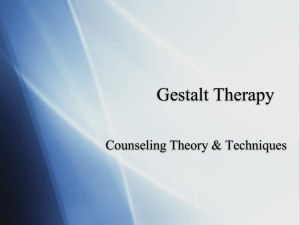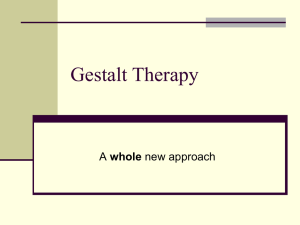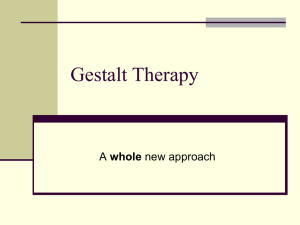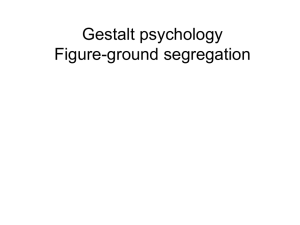LECTURE 6 Gestalt Therapy
advertisement
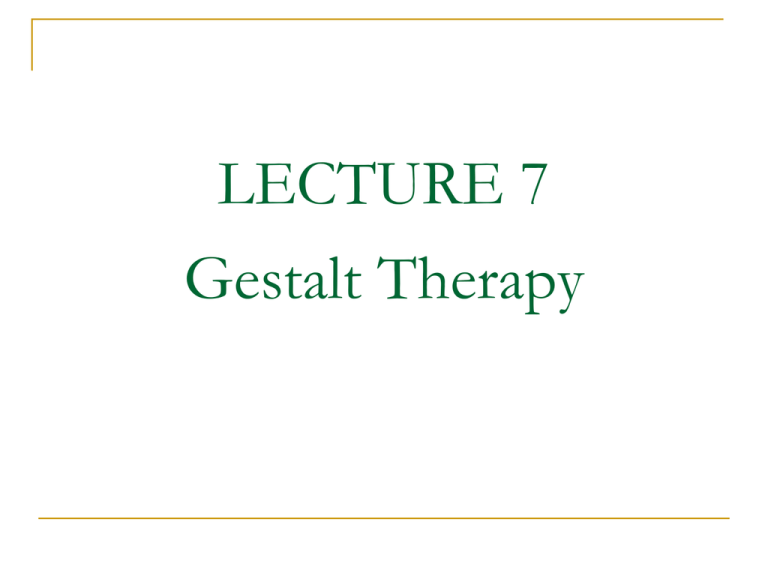
LECTURE 7 Gestalt Therapy Fritz Perls (1893-1970) Main originator and developer of Gestalt therapy. Born in Berlin, Germany, into a lower middle class Jewish family. He identified that himself as a source of trouble for his parents. Even he had been expelled from the school because of the difficulties with the authorities, his brilliant was never squashed and he returned-not only to complete the high school but to earn his medical degree (MD) with a specialization in psychiatry. Later, he worked with German Army and served as a medic in World War I. His experiences with soldiers who were gassed on the front lines led his interest in mental functioning, which led him to Gestalt psychology. After war, Perls worked with Kurt Goldstein in Frankfurt . It was through this association that he came to see the importance of viewing humans as a whole rather than as a sum of discretely functioning parts. Introduction Gestalt Therapy is an existential, phenomenological and process-based approach created on the premise that individual must be understood in the context of their ongoing relationship with the environment. Initial goal- clients to gain awareness of what they are experiencing and how they are doing it. Through this awareness, change automatically occurs. This approach is phenomenological because it focuses on the client’s perceptions of reality and existential because it is grounded in the notion that people are always in the process of becoming, remaking and rediscovering themselves. In a nutshell, this approach focuses on the here and now, the what and how, and the I/Thou of relating. In contrast to Perls’s way of working, contemporary Gestalt therapy stresses dialogue and relationship between client and therapist, sometimes called relational Gestalt therapy. Perls stressed a holistic approach to personality. Self acceptance, knowledge of the environment, responsibility for choices, and the ability to make contact with their field (a dynamic system of interrelationships) and the people in it are important awareness processes and goals, all of which are based on a here-and-now experiencing that is always changing. Key concepts - - i) ii) According to Fritz Perls : Clients have to grow up, stand on their own two feet and “deal with their life problems themselves”. Perl’s style of doing therapy involved 2 personal agendas: Moving client from environment support to selfsupport Reintegrating the disowned parts of one’s personality. Therapy aims not at analysis or introspection but at awareness and contact with the environment. The environment consist of both the external (other people) and internal (part of the self) of the worlds. The process of “reowning” parts of oneself that have been disowned and the unification process proceed step by step until clients become strong enough to carry on with their own personal growth. By becoming aware, clients become able to make informed choices and thus to live a more meaningful existence. Basic assumption of Gestalt therapy – individual have the capacity to self-regulate when they are aware of what is happening in and around them. According to the paradoxical theory of change, we change when we become aware of what we are as opposed to trying to become what we are not. It is good to have clients to “be” what they have to be rather than become what they “should be”. Principles of Gestalt Therapy Theory 1) 2) 3) 4) Holism Field theory The figure-formation process Organismic self-regulation Holism Gestalt is a German word meaning a whole or completion or a form that cannot be separated into parts without losing its essence. Gestalt therapists are interested in the whole person, they place no superior values on particular aspect of the individual. Gestalt practice attends to a client’s thoughts, feelings, behaviors, body, memories and dreams. Emphasis may be on a figure (those aspects of the individual’s experience that are most important at any moment) or the ground (those aspects of the client’s presentation that are often out of his or her awareness) Cues to this background (physical gestures, tone of voice,other nonverbal content). This often referred to by Gestalt therapists as “attending to the obvious,” while paying attention to how the parts fit together, how the individual makes contact with the environment and integration. Field Theory Field theory-grounded on the principle that the organism must be seen in its environment, or in its context, as part of the constantly field. Gestalt therapy rests on the principle that everything is relational, interrelated, and in process. Gestalt therapists pay attention to and explore what is occurring at the boundary between the person and the environment. The Figure-Formation Process Describes how the individual organizes experience from moment to moment. The figure-formation process tracks how some aspects of the environmental field emerges from the background and becomes the focal point of the individual’s attention and interest. The dominant needs of an individual at the given moment influence this process. Organismic Self-Regulation A process by which equilibrium is “disturbed” by the emergence of a need, a sensation, or an interest. Organisms will do their best to regulate themselves, given their own capabilities and the resources of their environment. What emerges in therapeutic work is associated with what is of interest to or what the client needs to be able to regain a sense of equilibrium. The Now Our “power is in the present” Nothing exists except the “now” The past is gone and the future has not yet arrived For many people the power of the present is lost They may focus on their past mistakes or engage in endless resolutions and plans for the future Unfinished Business Feelings about the past are unexpressed These feelings are associated with distinct memories and fantasies Feelings not fully experienced linger in the background and interfere with effective contact Result: Preoccupation, compulsive behavior, wariness oppressive energy and selfdefeating behavior Contact and Resistance to Contact Contact Interacting with nature and with other people without losing one’s individuality Boundary Disturbances/ resistance to contact The defenses we develop to prevent us from experiencing the present fully Contact Boundary Phenomenon Five different kinds of contact boundary disturbances: Introjection Projection Retroflection Deflection Confluence A Focus of Language “It” talk “You” talk Questions Language that denies power Listening to clients’ metaphors Listening for language that uncovers a story Therapeutic Techniques The experiment Exaggeration exercise Internal dialogue exercise Staying with the feeling Making the rounds Dream work Rehearsal exercise Reversal technique

